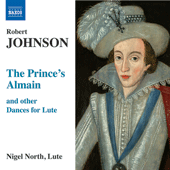|
| This is my post from this week's Tuesday Blog. |
This month, we will be discussing the music of not one, but two people named Robert Johnson. This week’s Robert Johnson (c. 1583 – 1633) was an English composer and lutenist of the late Tudor and early Jacobean eras. (To complicate things, he is sometimes called "Robert Johnson II" to distinguish him from an earlier Scottish composer…)
Playing a golden-toned 10-course lute and using original manuscript sources or his own reconstructions, British lutenist Nigel North is featured in today’s Cover 2 Cover in a delightful recital of dances by Robert Johnson. Although they use the old forms of pavan, galliard, almain and fantasie, Johnson’s exquisite works tend towards the more expansive, lyrical style that would later flourish in the Baroque period.
Robert Johnson was the son of a musician; John Johnson was lutenist to Elizabeth I. Following the death of his father in 1594, Robert Johnson was taken under the care of Sir George Carey (also known as Lord Hunsdon) who oversaw his education, including music. In 1597 Carey became the Lord Chamberlain to Elizabeth and was the patron of the acting company (known as The Lord Chamberlaine’s Men, later called The King’s Men) of which Shakespeare was a member. This created a strong artistic influence on Johnson, who went on to write songs and music for this company including plays by Shakespeare, Beaumont and Fletcher, and Webster. Johnson´s surviving compositions for the King's Men theatrical company have been dated to 1610–1617. Johnson's main claim to fame is that he composed the original settings for some of Shakespeare's lyrics, the best-known being probably those from The Tempest.
Johnson´s patron George Carey died in 1603. The following year Johnson found work at the court of James I where a number of lutenists were employed. Johnson’s most popular piece, surviving in over sixteen versions, was The Prince’s Almain, written for his pupil, Henry, Prince of Wales and son of King James I. Johnson also served at the court of Charles I, remaining on the royal payroll until 1633, the year of his death.
Johnson’s surviving lute music is a small collection of around 24 pieces. Early works for seven-course lute include the two Galliards and some of the Almains, most likely written before he joined the court of James I in 1604. The style of these early pieces is a little reminiscent of another Carey protégé, John Dowland, in their use of melody, divisions and texture. Soon, however, Johnson developed his own mature style represented in four Pavans and the Fantasie. Most of his later works are found in three great English manuscript sources for nine- or ten-course lute.
Robert Johnson’s lute music must have been well known in court music circles. We find several arrangements for keyboard. The lute pieces existing in keyboard versions include The Prince’s Almain, several other Almains, The Prince’s Coranto and a Pavan (set by Farnaby). This Pavan (No. 4) has not survived in its original lute version, so North created a new lute version from Farnaby’s arrangement.

Robert JOHNSON (c. 1583 – 1633)
- The Princes's Almain
- Pavan No. 1 in C Minor (*)
- Galliard, "My Lady Mildemays Delight"
- Pavan No. 2 in F Minor (*)
- Two Almains
- “The Noble Man”, from the Masque of the Middle Temple and Lincoln’s Inn (1613)
- “The Witches' Dance”, from Masque of Queens (1609)
- Pavan No. 3 in C Minor (*)
- Three Almains
- “The Fairies' Dance “, from the antimaeque of Oberon (1611)
- Fantasia (Fantasie) (*)
- Galliard (*)
- Almain, "Lady Strang's"
- Pavan No. 4 (reconstructed by N. North)
- The First, Second, and Third Dances in the Prince's Masque (from Oberon, 1611)
- Three Almains
- “Satyr's Dance”, from the antimaeque of Oberon (1611) (reconstructed by N. North)
Nigel North, 10 course lute
(after Hans Frei, by Lars Jönsson, Dalarö, Sweden, 2005 - Pitch: A 392)
NAXOS 8.572178
Details - http://www.naxos.com/catalogue/item...._code=8.572178
Internet Archive - https://archive.org/details/NigelNorthRobertJohnsonLuteWorksComplete

No comments:
Post a Comment